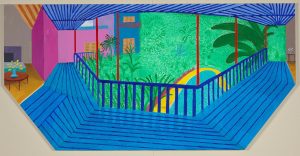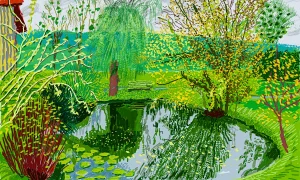Starting point
All people in the world can be conditionally divided into two types (as it is now fashionable to say in relation to anything): those whose fate is controlled by chance, and those in whose life predestination and destiny rule the ball. David Hockney with full confidence can be attributed to the second category. His life and career lined up in such a perfectly straight line that even strong shocks, not to mention minor accidents and troubles, could not affect them.

The future artist was born on July 9, 1937 in the family of Kenneth and Laura Hockney (he was the fourth of five children). David’s parents were strong-willed people who stood out from the rest of the inhabitants of decent English Bradford. Although Laura was a strict Methodist and tried to raise her children in accordance with her religious beliefs, she was also a staunch vegetarian, which was quite rare at that time. Kenneth Hockney did not fit into any framework at all. He participated in anti-war campaigns and became a conscientious objector during World War II. According to the artist, it was his father who taught him to remain himself in any situation and not pay attention to what others say. Hockney recalls that Kenneth was a real dandy: he always wore suits tailored exactly to his measurements. And, having reached a certain age, the artist put aside fancy glasses and fancy outfits to dress in a tailored suit and admit that nothing could be more comfortable.
The artist’s family is often described as puritanical and God-fearing, but Hockney himself once described it as “a working-class family of radicals.” It is not surprising that such unusual parents had a son like David. As a child, he was passionately in love with opera, and in his Sunday school lessons he drew caricatures of Christ, which infuriated teachers. At school (one of the best in the country), he simply ignored all subjects, except for painting lessons, and drew caricatures in notebooks on the rest. Oddly enough, his rebellious nature did not prevent the school authorities from seeing the boy’s talent, and he began to make comics for the school newspaper.
The Imaginarium
In his youth, David understood that he did not belong in England. The country, apparently, was not yet ready to accept the young artist with all his versatility and scope of imagination. While studying at the Art School of King’s College London, for the first time he felt at home, but he quickly absorbed all the necessary knowledge and skills and practically stopped paying attention to teachers. At the same time, Hockney began to talk about his sexual orientation for the first time (“We two boys together clinging”, 1961). But the artist gains real freedom only after moving to the States.

David fell in love with California landscapes as a child, when his father took him to the movies. The artist recalled how he was struck by the fact that in Hollywood films people and objects cast such thick shadows (he had not seen this in mostly overcast England). After finally moving to California in 1966, Hockney finally begins to see and write really bright things. It seems that the sun is not outside of his paintings, but directly inside them. And at the same time, in the artist’s works, especially on the famous canvases with pools and showers, his admiration for beautiful male bodies is fully manifested (“Peter gets out of Nick’s pool”, 1966, “Sunbathing”, 1966). “I lived among bohemians, and these people have always been tolerant. Besides, I decided that if I want to be an artist, I have to be honest,” Hockney explains his courage.
After moving to America, Hockney is fond of photography. He does not part with the camera, and often uses Polaroids as sketches for future paintings (in particular, the famous double portrait “Mr. and Mrs. Clark and Percy”, 1970-71, and the painting “Portrait of the Artist (Pool with two figures )”, 1972).
In the 70s, Hockney invents a new technique for working with photographs. Armed with a camera, he takes many shots of the same landscape, interior or person and creates amazing collages from them that look more like paintings (The Pearblossom Highway, 1986, Still Life with a Blue Guitar, 1982, Patrick Proctor) , 1982). The artist calls them “joiners”.
Continuing to experiment with techniques and travel around the world, David Hockney one day makes an unexpected discovery that has become the subject of controversy among art critics and historians for many years. In 2001, the artist published the book “Secret Knowledge”, on the basis of which the BBC made a documentary film in 2003. In this work, Hockney reveals the real secret behind the realism of Renaissance paintings: painters discovered mirror projections with Camera Lucida and Camera Obscura.
